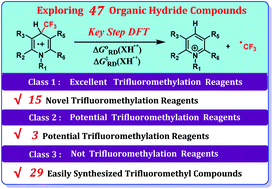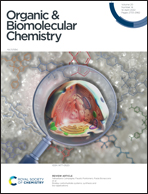Theoretical study for evaluating and discovering organic hydride compounds as novel trifluoromethylation reagents†
Abstract
Trifluoromethylation reaction is one of the significant and practical organic chemical reactions, and the design and discovery of novel trifluoromethylation reagents have been attracting more and more attention. Trifluoromethyl-substituted organic hydride compounds (XH) have the potential to be novel trifluoromethylation reagents in organic synthesis due to the favorable tendency of XH˙+ releasing ˙CF3 to form stable aromatic structures in terms of thermodynamics. The key elementary step of the trifluoromethylation is the radical cation (XH˙+) generation by catalysis or single-electron activation releasing ˙CF3 to form a stable aromatic structure, which also provides the thermodynamic driving force of the chemical process. In this work, 47 new trifluoromethylation reagent candidates of XHs were designed and calculated for the Gibbs free energy  and activation free energy [ΔG‡RD(XH˙+)] of XH˙+ releasing ˙CF3 using the density functional theory (DFT) method, in order to quantitatively measure the reactivity of XHs as trifluoromethylation reagents, and to establish the molecular library as well as reactivity database of novel trifluoromethylation reagents for synthetic chemists. According to the
and activation free energy [ΔG‡RD(XH˙+)] of XH˙+ releasing ˙CF3 using the density functional theory (DFT) method, in order to quantitatively measure the reactivity of XHs as trifluoromethylation reagents, and to establish the molecular library as well as reactivity database of novel trifluoromethylation reagents for synthetic chemists. According to the  and ΔG‡RD(XH˙+) values, all the XHs can be reasonably divided into 3 classes, including class 1 (excellent trifluoromethylation reagents), class 2 (potential trifluoromethylation reagents) and class 3 (not trifluoromethylation reagents). To our delight, 15 XHs with a 1,4-dihydropyridine structure and 3 XHs with a 3,4-dihydropyrimidin-2-one structure are identified to be novel excellent and potential trifluoromethylation reagents, respectively, according to their reactivity data. The relationship between the structural features, including methylation, heteroatom, substituents, conjugated structure and so on, and the reactivity of XHs as trifluoromethylation reagents are also discussed in this work. The computation results indicate that trifluoromethyl-substituted 1,4-dihydropyridine compounds and 3,4-dihydropyrimidin-2-one analogues could be possible trifluoromethylation reagents in organic synthesis. This work may provide the theoretical basis and references for discovering organic hydride compounds as novel reagents for trifluoromethylation or other alkylation reactions.
and ΔG‡RD(XH˙+) values, all the XHs can be reasonably divided into 3 classes, including class 1 (excellent trifluoromethylation reagents), class 2 (potential trifluoromethylation reagents) and class 3 (not trifluoromethylation reagents). To our delight, 15 XHs with a 1,4-dihydropyridine structure and 3 XHs with a 3,4-dihydropyrimidin-2-one structure are identified to be novel excellent and potential trifluoromethylation reagents, respectively, according to their reactivity data. The relationship between the structural features, including methylation, heteroatom, substituents, conjugated structure and so on, and the reactivity of XHs as trifluoromethylation reagents are also discussed in this work. The computation results indicate that trifluoromethyl-substituted 1,4-dihydropyridine compounds and 3,4-dihydropyrimidin-2-one analogues could be possible trifluoromethylation reagents in organic synthesis. This work may provide the theoretical basis and references for discovering organic hydride compounds as novel reagents for trifluoromethylation or other alkylation reactions.



 Please wait while we load your content...
Please wait while we load your content...